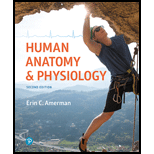
Which of the following are functions of the respiratory system? Circle all that apply.
a. Providing for speech
b. Regulating the autonomic nervous system
c. Maintaining the acid-base balance of the blood
d. Temperature homeostasis
e. Raising the pressure in the abdominopelvic cavity
f. Assisting in blood pressure regulation
Introduction:
The primary function of the respiratory system is a gaseous exchange between the body and the atmosphere. Lungs are the primary organs where this gaseous exchange occurs. This gaseous exchange leads to body tissues getting oxygen for performing metabolic reactions and releasing carbon dioxide as waste.
Answer to Problem 1CYR
Correct answer:
The respiratory system helps in speech, maintaining the acid–base balance of the blood, raising the pressure in the abdominopelvic cavity, and assisting in blood pressure regulation.
Explanation of Solution
Explanation for the correct answer:
Option (a) states that the respiratory system is responsible for producing speech. The larynx, an organ of respiratory system, houses vocal cords that are responsible for the production of sound. Vocal cords or vocal folds are essentially folding of the mucosal lining of the larynx. The core of the vocal cords has vocal ligaments and sound is produced as the air passes through vocal ligaments, which vibrate to produce sound. Hence, option (a) is correct.
Option (c) states that the respiratory system maintains acid–base balance of the blood. An important mechanism to maintain pH of the blood is by chemical-based buffer systems. The most important buffer system of blood is carbonic acid-bicarbonate buffer system. The primary source of carbonic acid and bicarbonate ions in blood is carbon dioxide. When the amount of carbon dioxide in the blood increases, the pH of the blood decreases (acidity increases). Respiratory system, being responsible for exhaling the carbon dioxide, assists in the maintenance of blood pH. Hence, option (c) is correct.
Option (e) states that the respiratory system raises the pressure in the abdominopelvic cavity. The respiratory system deals with breathing that eventually leads to gaseous exchange. Upon holding breath, the diaphragm rises above and the pressure in the abdominopelvic cavity increases. This pressure helps to expel out things in the cavity during urination, defecation, and childbirth. Hence, option (e) is correct.
Option (f) states that the respiratory system assists in blood pressure regulation. Capillaries in the lungs are responsible for the production of an enzyme that synthesizes angiotensin-II, a vasoconstrictor, thereby regulating blood pressure. Hence, option (f) is correct.
Explanation for the incorrect answers:
Option (b) states that the respiratory system controls the autonomous nervous system. However, the autonomous nervous system controls bronchial smooth muscles to regulate respiration. So, it is an incorrect option.
Option (d) states that the respiratory system helps in temperature homeostasis. Temperature homeostasis, in humans, is a function of the brain, skin, and circulatory system. So, it is an incorrect option.
Hence, options (b) and (d) are incorrect.
Therefore, it can be concluded that functions of the respiratory system are to produce speech, maintenance of an acid–base balance of the body, increasing the pressure of the abdominopelvic cavity, and regulation of blood pressure. These functions are performed along with the gaseous exchange that is the main function of the respiratory system.
Want to see more full solutions like this?
Chapter 21 Solutions
Pearson eText Human Anatomy & Physiology -- Instant Access (Pearson+)
- 9 S es Read the section "Investigating Life: In (Extremely) Cold Blood." Then, drag and drop the terms on the left to complete the concept map. Red blood cells Genes Icefishes -have mutated have colorless Oxygen have few lack encode Blood Cellular respiration consists of- contain carries is a Platelets White blood cells carries low amounts of Hemoglobin is necessary for Plasma Protein Reset.arrow_forwardPlating 50 microliters of a sample diluted by a factor of 10-6 produced 91 colonies. What was the originalcell density (CFU/ml) in the sample?arrow_forwardEvery tutor here has got this wrong, don't copy off them.arrow_forward
- Suppose that the population from question #1 (data is in table below) is experiencing inbreeding depression (F=.25) (and no longer experiencing natural selection). Calculate the new expected genotype frequencies (f) in this population after one round of inbreeding. Please round to 3 decimal places. Genotype Adh Adh Number of Flies 595 Adh Adh 310 Adhs Adhs 95 Total 1000 fladh Adh- flAdn Adh fAdhs Adharrow_forwardWhich of the following best describes why it is difficult to develop antiviral drugs? Explain why. A. antiviral drugs are very difficult to develop andhave no side effects B. viruses are difficult to target because they usethe host cell’s enzymes and ribosomes tometabolize and replicate C. viruses are too small to be targeted by drugs D. viral infections usually clear up on their ownwith no problemsarrow_forwardThis question has 3 parts (A, B, & C), and is under the subject of Nutrition. Thank you!arrow_forward
- They got this question wrong the 2 previous times I uploaded it here, please make sure it's correvct this time.arrow_forwardThis question has multiple parts (A, B & C), and under the subject of Nutrition. Thank you!arrow_forwardCalculate the CFU/ml of a urine sample if 138 E. coli colonies were counted on a Nutrient Agar Plate when0.5 mls were plated on the NA plate from a 10-9 dilution tube. You must highlight and express your answerin scientific notatioarrow_forward
- Basic Clinical Lab Competencies for Respiratory C...NursingISBN:9781285244662Author:WhitePublisher:Cengage
 Comprehensive Medical Assisting: Administrative a...NursingISBN:9781305964792Author:Wilburta Q. Lindh, Carol D. Tamparo, Barbara M. Dahl, Julie Morris, Cindy CorreaPublisher:Cengage Learning
Comprehensive Medical Assisting: Administrative a...NursingISBN:9781305964792Author:Wilburta Q. Lindh, Carol D. Tamparo, Barbara M. Dahl, Julie Morris, Cindy CorreaPublisher:Cengage Learning Human Physiology: From Cells to Systems (MindTap ...BiologyISBN:9781285866932Author:Lauralee SherwoodPublisher:Cengage Learning
Human Physiology: From Cells to Systems (MindTap ...BiologyISBN:9781285866932Author:Lauralee SherwoodPublisher:Cengage Learning  Concepts of BiologyBiologyISBN:9781938168116Author:Samantha Fowler, Rebecca Roush, James WisePublisher:OpenStax College
Concepts of BiologyBiologyISBN:9781938168116Author:Samantha Fowler, Rebecca Roush, James WisePublisher:OpenStax College





